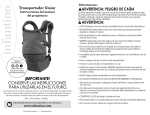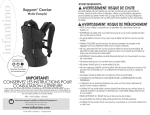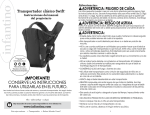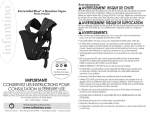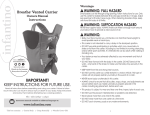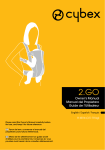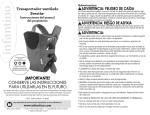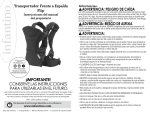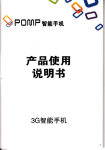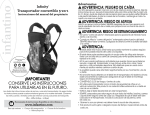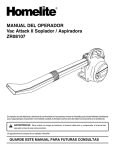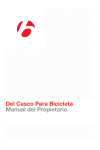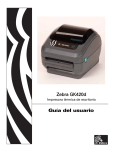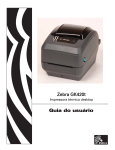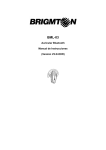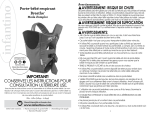Download BalanceTM Carrier
Transcript
TM Owners Manual Instructions Visit us online to view our instructional videos and learn more about our products at www.infantino.com IMPORTANT! KEEP INSTRUCTIONS FOR FUTURE USE. Read all instructions before assembling and using your carrier. Failure to follow each instruction can result in serious injury or death to your baby. 8lbs - 35lbs (3.6kgs 15.9kgs) This box contains: 1-sash 1-detachable hood 1-reversible front panel 1-mesh washing bag English Balance Carrier Warnings: WARNING: FALL HAZARD Small babies can fall through a leg opening. Follow instructions for use. Only use this carrier for babies between 8 lbs (3.6 kgs) and 35 lbs (15.9 kgs). Adjust the leg openings to fit the baby’s legs snugly. When using this carrier in the front position, ALWAYS keep one hand on the baby until the shoulder straps are properly positioned. DO NOT attempt to use the carrier in the backpack position without the assistance of a partner. The baby MUST be able to sit up on his/her own before being worn in the backpack position to avoid possible neck or back injury. Complies with safety requirements of ASTM F2236 and BS EN 13209-2:2005 WARNING: SUFFOCATION HAZARD NEVER lean against baby. ALWAYS make sure there is enough room around your baby’s face to provide a clear source of air. WARNING: • KEEP AWAY from fire and heat sources. • Your balance may be adversely affected by your movement and that of your baby. • DO NOT lean forward with the baby in the carrier. DO NOT bend at the waist – only bend at the knees to make sure the baby stays securely in the carrier. • This carrier is not suitable for use during sporting activities. • IMPORTANT! The baby must face towards you until he/she can hold head upright. • ALWAYS Check to assure all buckles, snaps, straps, and adjustments are secure before each use. • STOP! First time users should be assisted by a partner. • DO NOT USE PRODUCT IF DETERIORATION OR PROBLEMS ARE DETECTED. • DO NOT use this carrier as a child restraint in a motor vehicle. This product will not properly restrain your baby in the event of a crash. 1. Helpful Hints: * Facing-in position - Child Facing Toward You - Until your child is able to sit upright, this is the ideal position. Since there is no material between you and your infant, it affords your baby lots of close physical contact and attention, while leaving your hands free. In this position. you can entertain or bond with your newborn by talking, touching, playing or just making eye-contact. * How do you know if your baby is at the right height when worn in the front? - You should be able to tilt forward slightly and kiss the top of your child’s head. * When placing or removing your baby into or out of the carrier, sitting down will make the procedure easier. Until you are completely comfortable with the loading and unloading procedures, it is also safer to do so over a soft surface. TM * The Balance Carrier also contains a handy accessory pocket for keeping “essentials” close at hand (such as a phone, pacifier, keys, etc.) * Backpack Position - Child Facing Forward - ”It’s like a piggyback ride, but your hands are free.” When your little one can fully sit up on his or her own, putting them on your back allows you to carry the child comfortably for longer periods of time. In this position your baby is free to check out what is going on around them and still know that you are right there. * Wearing the carrier closer to your body and higher up on your back (or chest when worn in the front position) will minimize stress to your back and shoulders from prolonged use. Care Instructions Machine wash cold, separately, on gentle cycle. NO chlorine bleach or fabric softeners. Drip dry only, do not use dryer. Do not iron. 2. English TM * The Balance Carrier is designed for greater comfort for both you and your child, and more physical contact with your baby. Its design allows the child’s weight to be focused on the hips (where mothers have been carrying children for at least several thousand years). And because you can tolerate additional weight in this position, you can continue to carry your child even as they get older. Carrier Body Front: Top Shoulder Strap Tightener Shoulder Strap Head Support Leg Strap Tidy Loop Lumbar Support Belt 3. Carrier Body Back: Top Shoulder Strap Tightener Chest/Back Strap Head Support Pattern Area Leg Strap Lumbar Support Belt 4. Instructions: 1 Placing baby in your carrier: Facing-in position * Until your baby is able to hold his/her head upright, this is the ideal position. Since there is no material between you and your infant, if affords him or her lots of close physical contact and attention, while leaving your hands free. In this position, you can entertain or bond with your baby by talking, touching, playing or just making eye-contact. * IMPORTANT! Keep one hand on the baby until the shoulder straps are properly positioned. * IMPORTANT! Your baby must face toward you until he/she is able to hold head upright. 1. First, unfasten the buckle on the “lumbar support belt.” Pick up your carrier by the “lumbar support belt” with the inside “pattern area” of the carrier facing towards the front of your body. Place the “lumbar support belt” around you at your natural waist, and attach the belt buckle in the back. * Note: Persons with longer torsos may find a higher belt position more comfortable (closer to the navel); shorter people may wish to wear the belt more on the hips. 2. Tighten the “lumbar support belt” by pulling forward on its webbing strap. 3. For accessibility, move the “chest/back strap” (that attaches the “shoulder straps”) to as close to the top of the carrier as possible. Unfasten the buckle. 5. 5.6 Lift your baby facing towards your body to your natural waist. Make sure the baby’s legs wrap comfortably around your waist and are slipped through each leg hole. The “leg straps” should be above the baby’s legs. While holding the baby securely with the left hand, slip the “shoulder strap” onto your right shoulder. Switch hands and repeat with the other “shoulder strap.” * IMPORTANT! Before releasing your hold on the baby, ensure that the “shoulder straps” are securely in place. 6. 7 Once the straps are secure on your shoulders, reach over your shoulders and attach the “chest/back strap” to connect the two “shoulder straps” together. If you have difficulty reaching the buckle ask another person for assistance. 6. English 4.5 7.5 8.6 To bring the baby close against your body (or for a more comfortable fit), tighten the “shoulder straps” by pulling on the “top shoulder strap tighteners. Fit the baby’s legs snugly in the leg holes by adjusting the webbing on the” leg strap.” Adjust the “head support” to properly support the child’s head. 9. 10. 7 Roll any excess webbing and secure with an elastic “tidy loop.” Repeat with each strap to keep the carrier neat and any excess strap out of the way. Using removable bib: Facing-in position 11. 7 Direct contact between the baby and the parent is one of the best features of this carrier. However, when carrying the child in the front position, the “removable bib” may be used to protect the wearer’s clothing. Attach the bib directly onto each “shoulder strap” and center it on your chest between you and the baby. * IMPORTANT! The “removable bib” should only be used for the front, facing In position and NOT for the backpack position. 7. Removing the child from the carrier: Facing-in position First of all, reach over your shoulders and unbuckle the “chest/back strap.” 2.6 To facilitate extracting the baby’s legs, loosen the leg hole openings by adjusting the webbing on the “leg strap.” * IMPORTANT! Once the “chest/back strap” is unbuckled, keep at least one hand on the baby at all times. 3. 7 4. 7 5. 7 While holding the baby securely with the left hand, remove the right “shoulder strap.” Switch hands and repeat for the other side. Holding the baby with both hands, slide the child out of the front of carrier. Gently place the baby in a safe location before removing the carrier from your body. Unbuckle the “lumbar support belt” and remove the carrier. 8. English 1.5 2 Placing older baby in your carrier: Backpack position * IMPORTANT! For the backpack position, users must be assisted by a partner. * IMPORTANT! The baby MUST be able to sit up on his/her own before being worn in the backpack position to avoid possible neck or back injury. * IMPORTANT! The “removable bib” should NOT be used in the backpack position. 1. First, unfasten the buckle on the “lumbar support belt.” Pick up your carrier by the “lumbar support belt” and place it around you at your natural waist with the inside “pattern area” of the carrier facing toward your back. Attach the belt buckle in the front. * Note: Persons with longer torsos may find a higher belt position more comfortable (closer to the navel); shorter people may wish to wear the belt more on the hips. 2. Put one “shoulder strap” over your shoulder. 3. Have a second person carefully place the baby into the carrier, making sure that the baby’s legs go through the leg holes and wrap around your waist naturally. The “leg straps” should be above the baby’s legs. 4. While the other person is still holding the baby securely on your back, put your other arm through the “shoulder strap.” 9. With the second person still supporting your baby securely, buckle the “chest/back strap” and adjust it to a comfortable position. 6.6 Tighten the webbing at the base of each “shoulder strap” to adjust them for a more comfortable fit. 7. 7 Tighten the “top shoulder strap tighteners” to pull your baby closer to your body into the most comfortable position. 7 When the baby is secure in the backpack position, the assistant can release their support of the child. 8. 9. 7 10. 7 Adjust the webbing on the” leg straps” to fit the baby’s legs snugly in the leg holes. Roll any excess webbing and secure with an elastic “tidy loop.” Repeat with each strap to keep the carrier neat and any excess strap out of the way. 10. English 5.5 Removing older baby from the carrier: Backpack position * Note: For unloading your child from the backpack position, you may either use the assistance of a second person or perform the procedure alone using a secure corner (such as a couch). 1.5 For removal with assistance, have the second person support the child while you unfasten the buckles on the “chest/back strap” and the “lumbar support belt.” As the second person lifts the child in the carrier, remove both shoulder straps. Loosen both “leg straps” and lift the child out of the carrier. 2.6 For removal by yourself, sit down slowly and carefully in a secure corner before removing the carrier. * IMPORTANT! NEVER lean against the baby. ALWAYS make sure there is enough room around your baby’s face to provide a clear source of air. 3. 7 4. 7 5. 7 Unbuckle the “chest/back strap” and the “lumbar support belt”. Remove the “shoulder straps” and slowly lower the baby off your back into the secure corner. Loosen both “leg straps” to facilitate extracting the child’s legs. Carefully slide the baby out of the carrier. 6. 7 11. Manual del propietario de Balance Carrier TM Español ¡IMPORTANTE! Conserve estas instrucciones para utilizarlas MÁs adelante. Lea todas las instrucciones antes de armar y usar su transportador. No seguir todas estas instrucciones puede dar como resultado lesiones graves o la muerte de su bebé. 8lbs - 35lbs (3.6kgs 15.9kgs) Esta caja contiene: 1 transportador 1 babero desprendible Advertencias: ADVERTENCIA: PELIGRO DE CAÍDAS Los niños pequeños pueden caer por una de las aberturas para las piernas. Siga las instrucciones de uso. Sólo use este transportador con niños de entre 8 lb (3.6 kg) y 35 lb (15.9 kg). Ajuste las aberturas para las piernas de modo que se adapten bien a las piernas de su bebé. Al usar este transportador en posición frontal, SIEMPRE mantenga una mano en el bebé hasta que las correas de los hombros estén en la posición correcta. NO intente usar el transportador en posición de mochila sin la ayuda de otra persona. El bebé DEBE poder sentarse por sí mismo antes de llevarse en posición de mochila, para evitar posibles lesiones en el cuello o la espalda. Cumple o supera las normas ASTM F2236 y BS EN 13209-2:2005. ADVERTENCIA: RIESGO DE ASFIXIA NUNCA se incline contra el bebé ni lo oprima. SIEMPRE asegúrese de que haya suficiente espacio alrededor del rostro de su bebé para proporcionar una fuente de aire libre. ADVERTENCIA: • CONSÉRVELO LEJOS del fuego y fuentes de calor. • Su equilibrio se puede ver afectado negativamente por su movimiento y el de su hijo. • No se incline hacia delante cuando tenga al bebé en el transportador. No se doble por la cintura al inclinarse; sólo doble las rodillas para asegurarse de que el bebé se mantenga fijo en el transportador. • Este transportador no es adecuado para ser usado durante actividades deportivas. • ¡IMPORTANTE! El niño debe mirar hacia usted hasta que pueda mantener erguida la cabeza. • SIEMPRE revise para asegurarse de que todas las hebillas, broches, correas y ajustes estén firmes antes de cada uso. • ¡ALTO! Quienes lo usan por primera vez deben contar con la ayuda de otra persona. • NO USE EL PRODUCTO SI SE DETECTAN DETERIOROS O PROBLEMAS. • NO use este transportador como fijación para el niño en un vehículo de motor. Este producto no retendrá debidamente a su hijo en caso de un choque. 13. Sugerencias Útiles: TM * El Transportador Balance está diseñado para una mayor comodidad tanto de usted como de su hijo, y para un mayor contacto físico con su bebé. Su diseño permite que el peso del niño se concentre en las caderas (donde las madres han estado cargando a sus hijos durante al menos varios miles de años). Y dado que usted puede tolerar peso adicional en esta posición, puede seguir cargando a su hijo incluso cuando sea mayor. * Posición frontal - Niño mirando hacia usted - Hasta que el niño pueda sentarse erguido, ésta es la posición ideal. Dado que no hay materiales entre usted y su bebé, le da a éste mucho contacto físico cercano y atención, al tiempo que le deja libres las manos. En esta posición, puede divertir a su bebé y establecer lazos con él hablando, tocándose, jugando o simplemente mirándose a los ojos. * Cómo sabe si el bebé está a la altura correcta cuando lo lleva al frente? - Usted debe poder inclinarse ligeramente y besar la parte superior de la cabeza de su bebé. TM * El Transportador Balance también contiene una útil bolsa para accesorios que le permite mantener a mano artículos “esenciales” (como el teléfono, el chupón, las llaves, etc.) * Posición de mochila - Niño mirando hacia delante - “Es como un paseo a caballito, pero sus manos están libres”. Cuando su pequeño se pueda sentar erguido totalmente por sí mismo, llevarlo en la espalda le permite transportarlo cómodamente durante períodos de tiempo más prolongados. En esta posición, su bebé tiene libertad de revisar lo que está pasando a su alrededor y seguir sabiendo que usted está allí. * Llevar el transportador más cerca de su cuerpo y más alto en la espalda (o en el pecho cuando lo lleve en posición frontal) reducirá al mínimo la tensión en su espalda y hombros por el uso prolongado. Instrucciones Para el Cuidado: Lave a máquina con agua fría, por separado, en ciclo para prendas delicadas. NO use blanqueador de cloro ni suavizantes de telas. Séquelo colgándolo únicamente; no use la secadora de ropa. No lo planche. 14. Español * Al cargar o descargar a su bebé en el transportador, sentarse hará más seguro el procedimiento. Hasta que esté totalmente cómoda con los procedimiento de carga y descarga, también es más seguro hacerlo en una superficie suave. Transportador de Frente: Tensor superior de la correa para el hombro Correa para el hombro Soporte de la cabeza Correa para la pierna Lazo organizador Cinturón de soporte lumbar 15. Transportador de Atras: Tensor superior de la correa para el hombro Correa del pecho y la espalda Soporte de la cabeza Correa para la pierna Cinturón de soporte lumbar 16. Español Área con dibujo Instructions: 1 Para colocar al bebé en el transportador: Posición frontal * El bebé debe poder sentarse por sí mismo antes de poderse usar en posición de mochila. Dado que no hay material entre usted y su bebé, te da mucho contacto físico cercano y la atención, dejando las manos libres. En esta posición, puede entretener o vínculo con su bebé por hablar, tocar, jugar o simplemente hacer contacto visual. * ¡IMPORTANTE! SIEMPRE mantenga una mano en el bebé hasta que todas las hebillas y correas estén debidamente cerradas. * ¡IMPORTANTE! En este transportador, su hijo ÚNICAMENTE debe llevarse en la posición de “mirando hacia dentro”. 1. Para empezar, suelte las hebillas del “cinturón de soporte lumbar”. Recoja el transportador por el “cinturón de soporte lumbar” con el “área con dibujo” interior del transportador mirando hacia el frente de su cuerpo. Coloque el “cinturón de soporte lumbar” alrededor de usted en su cintura natural y cierre la hebilla del cinturón en la espalda. * Nota: Las personas con torsos más largos pueden hallar más cómodo el cinturón en una posición más alta (más cerca del ombligo), y las personas más bajas quizá quieran usar el cinturón más en las caderas. 2. Apriete el “cinturón de soporte lumbar” tirando hacia delante de su correa trenzada. 3. Par efectos de accesibilidad, lleve la “correa del pecho y la espalda” (que se conecta con las “correas del hombro”) tan cerca de la parte superior del transportador como sea posible. Suelte la hebilla. 17. 4.5 5.6 Levante al bebé mirando hacia usted hasta su cintura natural. Asegúrese de que las piernas del bebé le rodeen cómodamente la cintura y pasen por cada agujero para las piernas. Las “correas para las piernas” deben estar encima de las piernas del bebé. * ¡IMPORTANTE! Antes de soltar al bebé, asegúrese de que las “correas para los hombros” estén firme mente en su sitio. 6. 7 Una vez que las correas estén seguras sobre sus hombros, lleve la mano por encima de los hombros y cierre la “correa del pecho y la espalda” para conectar las dos “correas para el hombro” entre sí. Si tiene dificultades para alcanzar la hebilla, pídale ayuda a otra persona. 18. Español Sosteniendo al bebé firmemente con la mano izquierda, pase la “correa para el hombro” sobre su hombro derecho. Cambie de manos y repita la acción con la otra “correa para el hombro.” 7.5 8.6 Para acercar al bebé estrechamente contra su cuerpo (o para un ajuste más cómodo) apriete las “correas para el hombro” tirando de los “tensores superiores de la correa para el hombro.” Ajuste bien las piernas del bebé en los agujeros para las piernas ajustando la banda trenzada de la “correa para la pierna.” Ajuste el “soporte del “soporte para la cabeza” para sostener correctamente la cabeza del niño. 9. 10. 7 Enrolle cualquier cincha excedente y fíjela con un “lazo organizador” elástico.Repita la acción con todas las correas para mantener el transportador ordenado y sin que estorben las correas sobrantes. Usando un babero extraíble: Posición frontal 11. 7 El contacto directo entre el bebé y sus padres es una de las mejores características de este transportador. No obstante, al llevar el niño en posición frontal, se puede usar el “babero desprendible” para proteger la ropa del usuario. Fije el babero en cada una de las “correas para el hombro” y céntrelo en el pecho entre usted y el bebé. * ¡IMPORTANTE! El “babero extraíble” sólo debe utilizarse para el frente, mirando en la posición y no por la posición de la mochila. 19. Para sacar al bebé del transportador: Posición frontal 1.5 Primero, pase la mano sobre los hombros y abra la hebilla de la “correa del pecho y la espalda.” 2.6 Para sacar más fácilmente las piernas del bebé, afloje los agujeros para las piernas ajustando la banda trenzada de la “correa para la pierna.” 7 Sosteniendo al bebé firmemente con la mano izquierda, quite la “correa del hombro” del lado derecho. Cambie de manos y repita la acción del otro lado. 7 Sosteniendo al bebé con ambas manos, deslícelo para sacarlo por el frente del transportador. Coloque al bebé suavemente en un lugar seguro antes de quitarse el transportador del cuerpo. 3. 4. 5. 7 Suelte la hebilla del “cinturón de soporte lumbar” y quítese el transportador. 20. Español * ¡IMPORTANTE! Una vez que se haya soltado la hebilla de la “correa del pecho y la espalda”, mantenga al menos una mano en el bebé en todo momento. 2 Para colocar al bebé en el transportador: Posición de mochila * ¡IMPORTANTE! Para cargar a su hijo con seguridad en la posición de mochila, se requiere la ayuda de otra persona. * ¡IMPORTANTE! poder sentarse erguido por sí mismo antes de poder llevarlo en posición de mochila. * ¡IMPORTANTE! El “babero desprendible” NO debe usarse en la posición de mochila. 1. 1. Para empezar, suelte las hebillas del “cinturón de soporte lumbar”. Recoja el transportador por el “cinturón de soporte lumbar” y colóqueselo en la cintura natural con el “área con dibujo” interior del transportador mirando hacia su espalda. Cierre la hebilla del cinturón al frente. * Nota: Las personas con torsos más largos pueden hallar más cómodo el cinturón en una posición más alta (más cerca del ombligo), y las personas más bajas quizá quieran usar el cinturón más en las caderas. 2. Ponga una “correa para el hombro” sobre el hombro. 3. Pida a otra persona que coloque cuidadosamente al bebé en el transportador, asegurándose de que las piernas del bebé pasen por los agujeros para las piernas y rodeen su cintura de modo natural. Las “correas para las piernas” deben estar encima de las piernas del bebé. 4. Mientras la otra persona sigue sosteniendo al bebé firmemente en su espalda, pase el otro brazo por la “correa para el hombro.” 21. Con la otra persona todavía sosteniendo al bebé firmemente, cierre la hebilla de la “correa del pecho y la espalda” y ajústela en una posición cómoda. 6.6 Apriete la banda trenzada en la base de cada “correa para el hombro” para colocarla en un ajuste cómodo. 7. 7 Apriete los “tensores superiores de la correa para el hombro” para acercar más al bebé a su cuerpo en la posición más cómoda. 7 Cuando el bebé esté seguro en la posición de mochila, el asistente puede dejar de sostener al bebé. 7 Ajuste la banda trenzada de las “correas para las piernas” para que las piernas del bebé se ajusten bien a los agujeros para las piernas. 8. 9. 10. 7 Enrolle cualquier banda trenzada excedente y fíjela con un ‘lazo organizador’ elástico. Repita la acción con todas las correas para mantener el transportador ordenado y sin que estorben las correas sobrantes. 22. Español 5.5 Para sacar al bebé del transportador: Posición de mochila * Nota: Para descargar al niño de la posición de mochila, puede usar la ayuda de otra persona o realizar el procedimiento en solitario en una esquina segura (como la de un sofá). 1.5 Para quitárselo con ayuda, pida que la otra persona sostenga al niño mientras desabrocha las hebillas de la “correa del pecho y la espalda” y el “cinturón de soporte lumbar”. Conforme la otra persona levanta al niño en el transportador, quítese ambas correas del hombro. Afloje las dos “correas para las piernas” y saque al bebé del transportador. 2.6 Para quitárselo en solitario, siéntese lenta y cuidadosamente en una esquina segura antes de quitarse el transportador. * ¡IMPORTANTE! SIEMPRE asegúrese de que haya suficiente espacio alrededor del rostro de su bebé para proporcionar una fuente de aire libre. NUNCA se incline contra el bebé en el transportador. 3. 7 4. 7 5. 7 6. 7 Libere la “correa del pecho y la espalda” y el “cinturón de soporte lumbar.” Quite las correas para los hombros” y baje entamente al bebé de su espalda al rincón seguro. Afloje ambas “correas para las piernas” para facilitar la extracción de las piernas del niño. Deslice cuidadosamente al bebé fuera del transportador. 23. 24. Designed with in California © 2010 Infantino, LLC 4920 Carroll Canyon Road, Suite 200 | San Diego, CA 92121 USA www.infantino.com A Step2 Family Company® Infantino, Ltd. Prospect House Business Center, High Wycomb HP13 6LA, UK BEFORE USING THIS CARRIER: Review and save the Instruction Manual for future reference. Please call Infantino at 1-800-840-4916 (for US or Canada) or 00+1 858-457-9797 in Europe with any questions or visit our website www.infantino.com. ANTES DE USAR ESTE TRANSPORTADOR: Revise y guarde el Manual de Instrucciones para consultarlo posteriormente. Llame a Infantino al 1-800-840-4916 (para los EE.UU. o Canadá) o al 00+1 858-457-9797 en Europa para hacer cualquier pregunta, o visite nuestro sitio Web en www infantino.com.






























